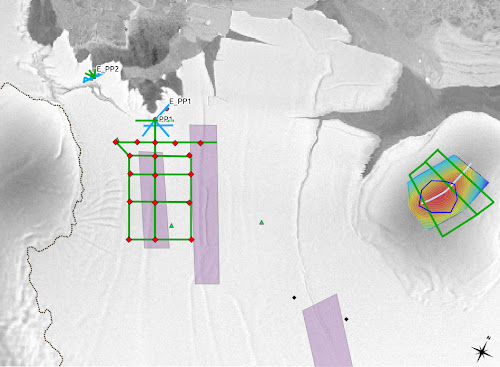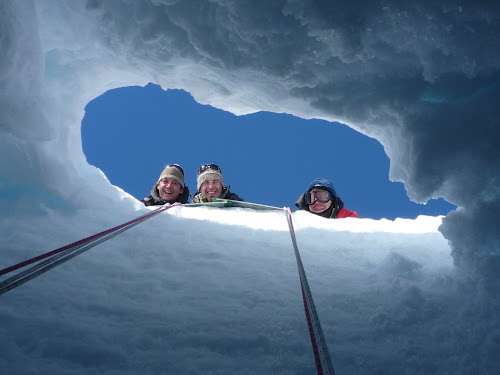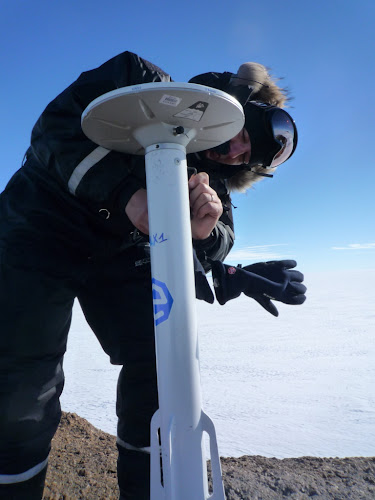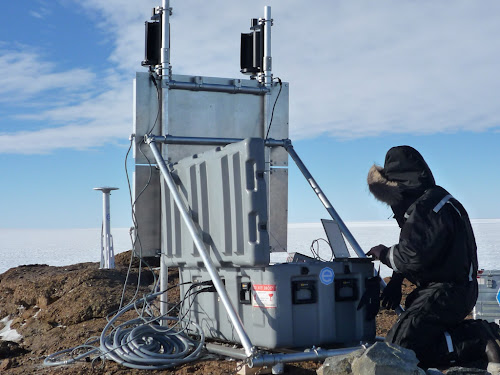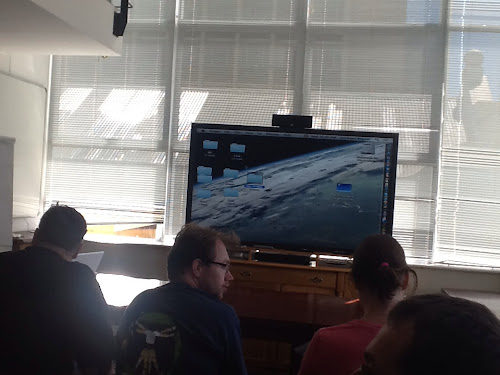The IceCon team is back at PEA after a successful trip to the Derwael Ice Rise. So here is a brief update of the activities that took place during that two-weeks period.
 |
| Morgane proudly showing a piece of core |
It took 22 hours to get to Derwael Ice Rise, driving all day and all night. Once camp established, the ice core drilling operations started. This went quite smooth for the first tens of meters, but a series of problems occurred, especially near a depth of 60m, where further drilling became seemingly impossible. Nevertheless, thanks to the continuous efforts of everyone around camp (drillers, support people from BELARE such as Kristof and even an inventive approach from the field guide Raphy), they finally got through that difficult bit and succeeded in drilling up to 120 m of core. At that depth, the ice seemed rather hard to go through and it is not clear for the moment what the origin of this could be. The site is on an ice rise, influenced by the Raymond effect and therefore different from other areas where a similar drill has been used. In the end, the televiewer was lowered down in the borehole to completely image the internal structure, which will make it possible to count internal layers within the firn part and maybe beyond.
 |
| ROB1 power station and receiver |
From the beginning of the field activities we also started on erecting the ROB1 cGPS point. This takes a bit more time than the ULX1 point on Seal. It consists of digging a large snow pit to lower down the power plant (batteries, solar panels and wind turbines). Digging was also the key word for mounting the GPS antenna and securing the whole thing for winter. After a couple of days, ROB1 was operational and setup as a base station for all other GPS activities that were carried out in the area.
 |
Coffee-can marker: a steel cable goes via two
pulleys through a hole in the firn where it is
held tight with an anchor. |
Digging continued to make water for hot water drilling. Since ROB1 is on the ice and prone to vertical ice movements, we need to have an insight into the processes that govern that motion (compression and strain). Therefore, we set up a series of markers at different depths in the firn, ranging from 10 to 50m of depth. These markers are a steel cable anchored at depth and connected to the surface. Every year, the length of the cable will be measured, leading to a series of relative displacements. The hot water drilling required 2500 liters of liquid snow, which implied digging, melting and hosing. This took a day and a half to do and in nice weather was quite a leisurely job. Drilling in itself took less than an hour (it is like cooking a meal for hours and finishing dinner in 10 minutes). The so-called coffee-can markers (designed by Kristof and Greg at PEA and field proven afterwards) were thus easily installed.
 |
Denis and his high-frequency radar: whenever it goes well,
it is a boring job to do! |
On and around the Derwael ice rise, an intensive network of high- and low-frequency radar lines have been surveyed, revealing not one Raymond bump, but two. Moreover, the quality of the data is superior to the data gathered two years ago during the BELISSIMA programme, so that we are sure to have a complete 3D view of the dome area. Besides a strain network was established around the dome so that we can monitor the horizontal deformation precisely.
Besides the IceCon project, the Be:Wise project was also very successful. They established camp on the Roi Baudouin ice shelf and surveyed near to 180 km of radar data (both high and low frequency) and monitored 20 stakes on horizontal and vertical displacement using precise GPS. The markers will be re-surveyed next year.
 |
| Be:Wise: don't fool with us, because we are professionals! |
In short, more than expected has been done in relatively little time. The spirits in camp were always high and it was a fun thing to do. We could rely on a professional support team and surely, the good and balmy weather made us work every day. It is Antarctica, but also the coast, and recorded temperatures were regularly positive.
The return trip was more of a burden with poor visibility, bad and soft snow conditions and too high temperatures on the ice shelf so that the hydraulic system of the Prinoths went to high so that we had to stop at regular times. It took us a bit less than 30 hours to return to the station.







